Abstract
Erythrocytes coated with varying amounts of human complement were used to detect lymphocytes with complement receptors from normal subjects and patients with chronic lymphocytic leukemia. The relationship between the percentage of lymphocytes rosetting and the quantity of C3 present on complement-coated erythrocytes were studied. Small quantities of C3 (less than 5 fg/erythrocyte) caused maximal rosetting of normal lymphocytes. Maximal rosetting with chronic lymphocytic leukemia lymphocytes was not reached until much greater amounts of C3 were used to coat the erythrocytes. This difference in sensitivity to erythrocyte-bound complement was not due to an increased fraction of complement receptor-bearing cells in the leukemic patients. This loss of sensitivity of the chronic lymphocytic leukemia lymphocyte for complement may play a role in the immune deficiency present in this disease.
Full text
PDF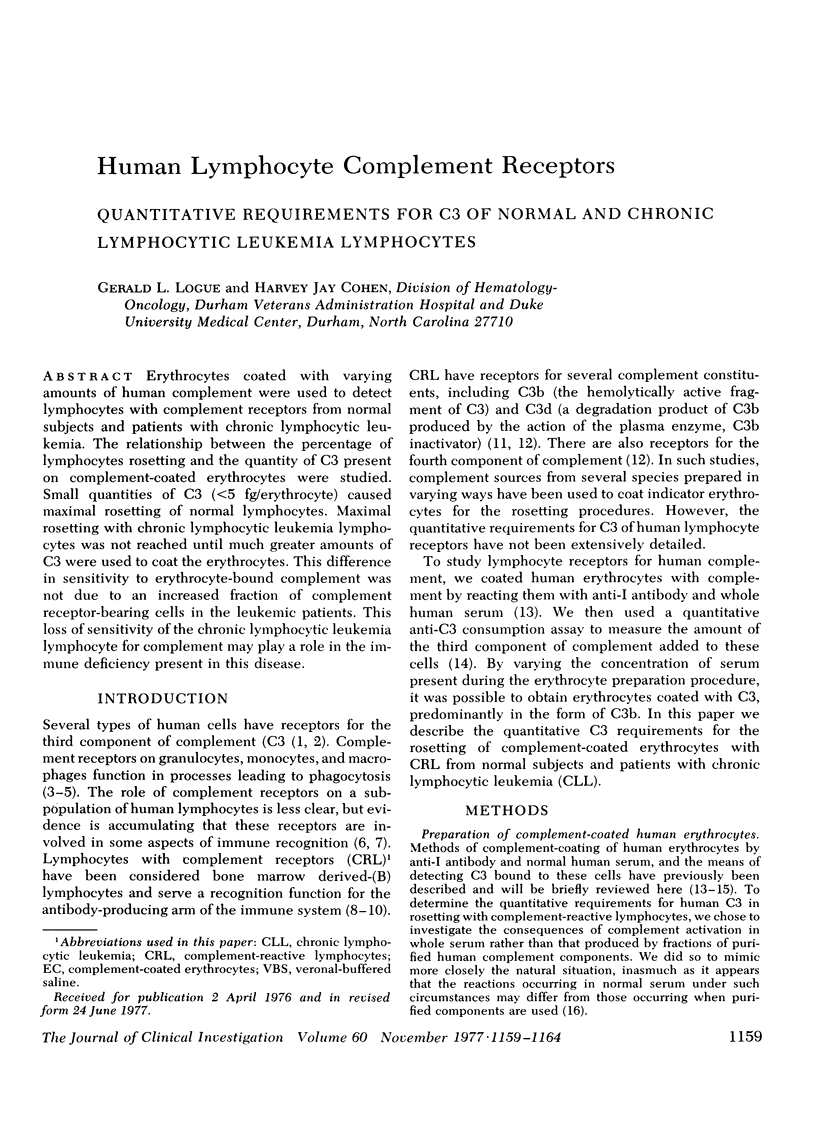
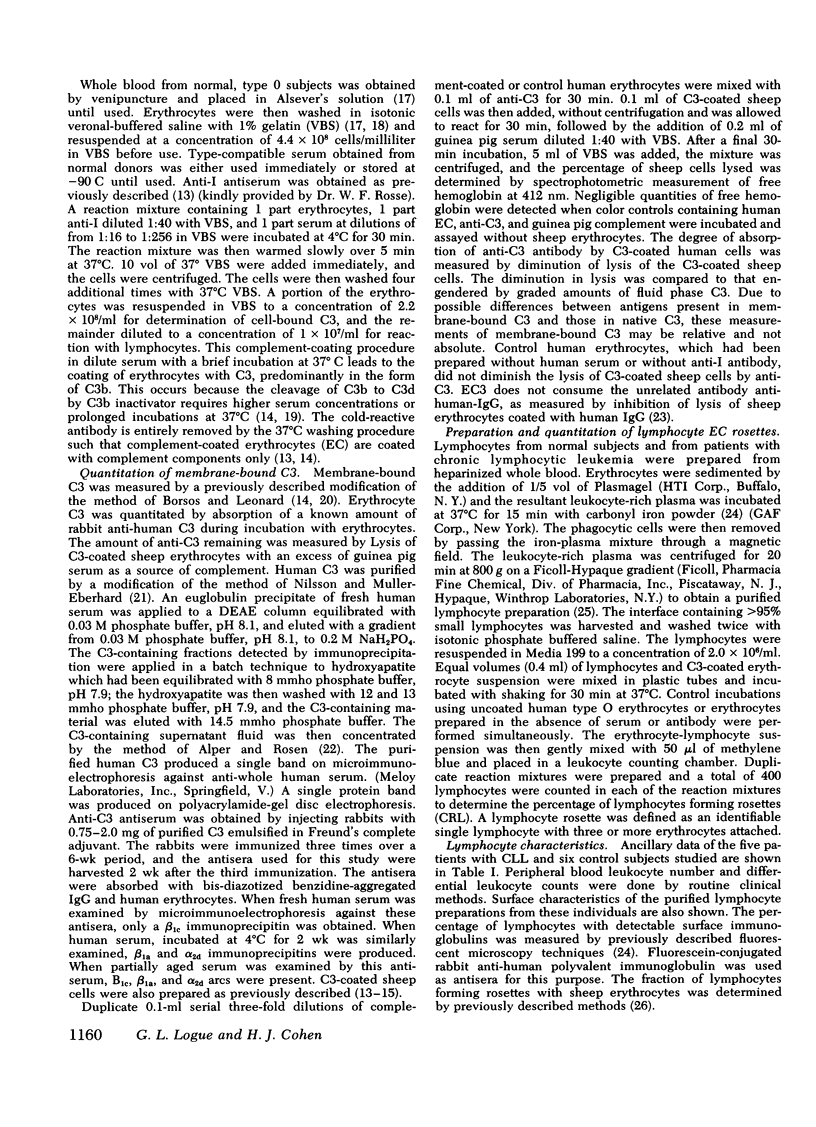
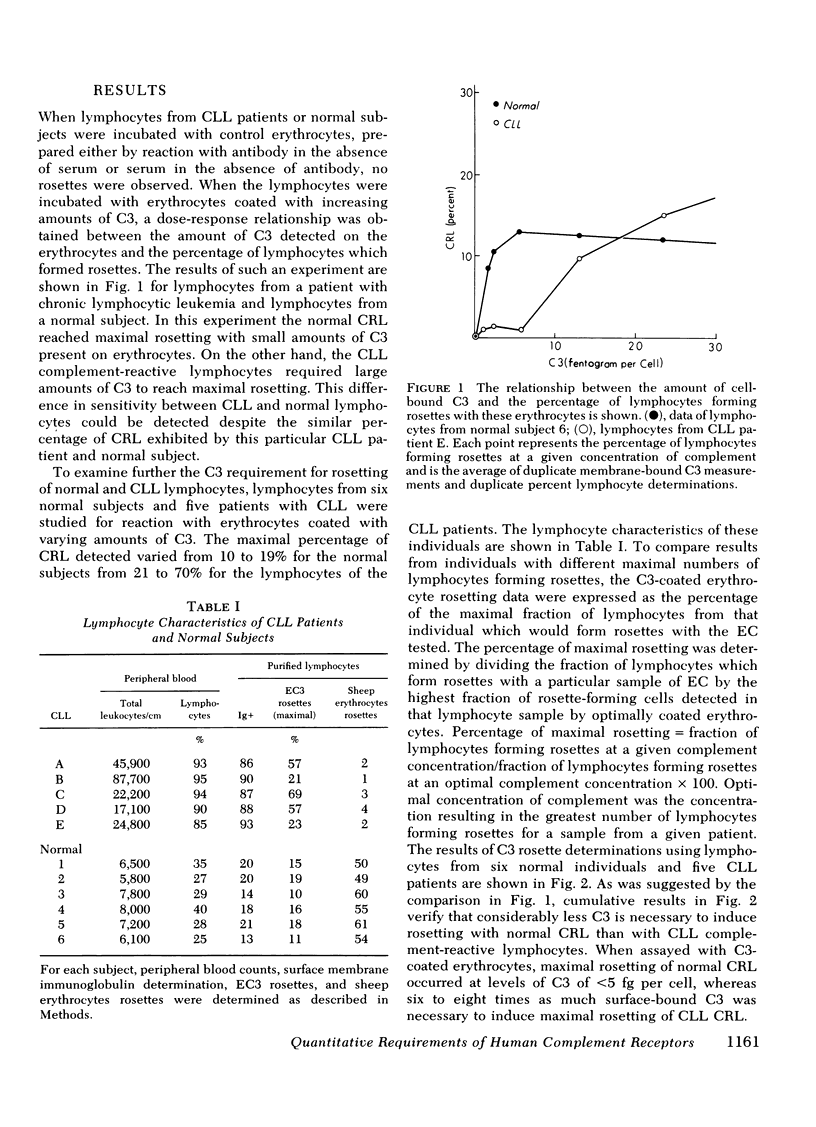
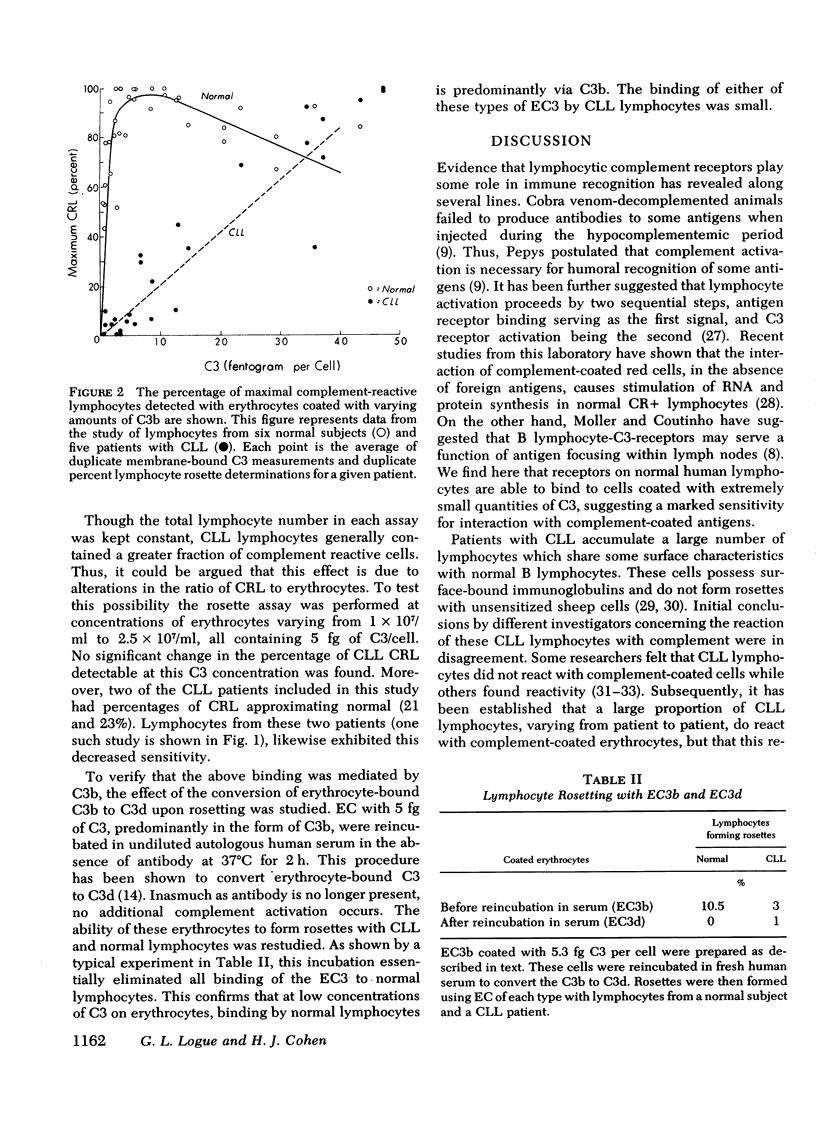
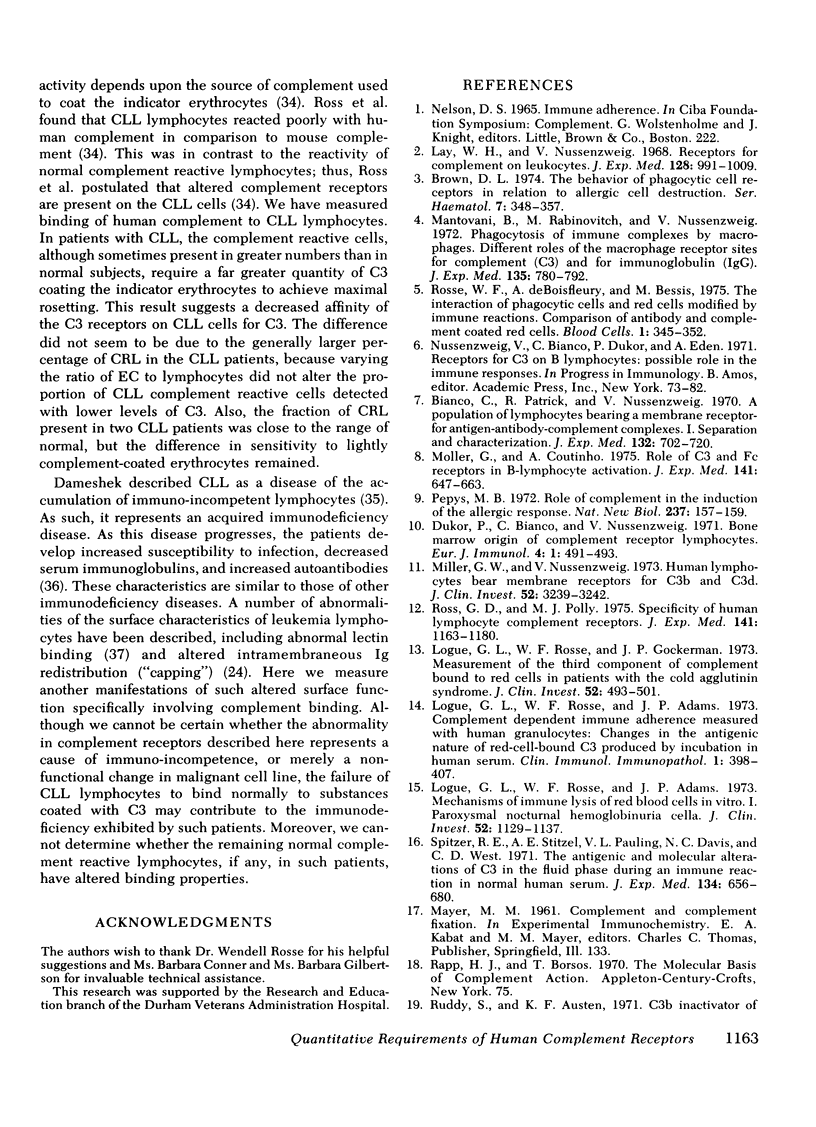

Selected References
These references are in PubMed. This may not be the complete list of references from this article.
- Alper C. A., Rosen F. S. Alper CA, Rosen FS: Studies of the in vivo behavior of human C'3 in normal subjects and patients. J Clin Invest. 1967 Dec;46(12):2021–2034. doi: 10.1172/JCI105691. [DOI] [PMC free article] [PubMed] [Google Scholar]
- Bianco C., Patrick R., Nussenzweig V. A population of lymphocytes bearing a membrane receptor for antigen-antibody-complement complexes. I. Separation and characterization. J Exp Med. 1970 Oct 1;132(4):702–720. doi: 10.1084/jem.132.4.702. [DOI] [PMC free article] [PubMed] [Google Scholar]
- Borsos T., Leonard E. J. Detection of bound C3 by a new immunochemical methods. J Immunol. 1971 Sep;107(3):766–771. [PubMed] [Google Scholar]
- Brown D. L. The behaviour of phagocytic cell receptors in relation to allergic red cell destruction. Ser Haematol. 1974;7(3):348–357. [PubMed] [Google Scholar]
- Cohen H. J. Human lymphocyte surface immunoglobulin capping. Normal characteristics and anomalous behavior of chronic lymphocytic leukemic lymphocytes. J Clin Invest. 1975 Jan;55(1):84–93. doi: 10.1172/JCI107921. [DOI] [PMC free article] [PubMed] [Google Scholar]
- Dameshek W. Chronic lymphocytic leukemia--an accumulative disease of immunolgically incompetent lymphocytes. Blood. 1967 Apr;29(4 Suppl):566–584. [PubMed] [Google Scholar]
- Dukor P., Bianco C., Nussenzweig V. Bone marrow origin of complement-receptor lymphocytes. Eur J Immunol. 1971 Dec;1(6):491–494. doi: 10.1002/eji.1830010617. [DOI] [PubMed] [Google Scholar]
- Dukor P., Hartmann K. U. Hypothesis. Bound C3 as the second signal for B-cell activation. Cell Immunol. 1973 Jun;7(3):349–356. doi: 10.1016/0008-8749(73)90199-8. [DOI] [PubMed] [Google Scholar]
- Eden A., Miller G. W., Nussenzweig V. Human lymphocytes bear membrane receptors for C3b and C3d. J Clin Invest. 1973 Dec;52(12):3239–3242. doi: 10.1172/JCI107525. [DOI] [PMC free article] [PubMed] [Google Scholar]
- Grey H. M., Rabellino E., Pirofsky B. Immunoglobulins on the surface of lymphocytes. IV. Distribution in hypogammaglobulinemia, cellular immune deficiency, and chronic lymphatic leukemia. J Clin Invest. 1971 Nov;50(11):2368–2375. doi: 10.1172/JCI106735. [DOI] [PMC free article] [PubMed] [Google Scholar]
- Inbar M., Ben-Bassat H., Sachs L. Difference in the mobility of lectin sites on the surfact membrane of normal lymphocytes and malignant lymphoma cells. Int J Cancer. 1973 Jul 15;12(1):93–99. doi: 10.1002/ijc.2910120110. [DOI] [PubMed] [Google Scholar]
- Jondal M., Holm G., Wigzell H. Surface markers on human T and B lymphocytes. I. A large population of lymphocytes forming nonimmune rosettes with sheep red blood cells. J Exp Med. 1972 Aug 1;136(2):207–215. doi: 10.1084/jem.136.2.207. [DOI] [PMC free article] [PubMed] [Google Scholar]
- Lay W. H., Nussenzweig V. Receptors for complement of leukocytes. J Exp Med. 1968 Nov 1;128(5):991–1009. doi: 10.1084/jem.128.5.991. [DOI] [PMC free article] [PubMed] [Google Scholar]
- Logue G. L., Huang A. T. Human lymphocyte complement receptors. Stimulation of lymphocyte RNA synthesis by complement-coated human red cells. Clin Immunol Immunopathol. 1977 Sep;8(2):161–170. doi: 10.1016/0090-1229(77)90106-4. [DOI] [PubMed] [Google Scholar]
- Logue G. L., Rosse W. F., Adams J. P. Complement-dependent immune adherence measured with human granulocytes: changes in the antigenic nature of red cell-bound C3 produced by incubation in human serum. Clin Immunol Immunopathol. 1973 Apr;1(3):398–407. doi: 10.1016/0090-1229(73)90056-1. [DOI] [PubMed] [Google Scholar]
- Logue G. L., Rosse W. F., Adams J. P. Mechanisms of immune lysis of red blood cells in vitro. I. Paroxysmal nocturnal hemoglobinuria cells. J Clin Invest. 1973 May;52(5):1129–1137. doi: 10.1172/JCI107279. [DOI] [PMC free article] [PubMed] [Google Scholar]
- Logue G. L., Rosse W. F., Gockerman J. P. Measurement of the third component of complement bound to red blood cells in patients with the cold agglutinin syndrome. J Clin Invest. 1973 Feb;52(2):493–501. doi: 10.1172/JCI107206. [DOI] [PMC free article] [PubMed] [Google Scholar]
- Logue G. Felty's syndrome: granulocyte-bound immunoglobulin G and splenectomy. Ann Intern Med. 1976 Oct;85(4):437–442. doi: 10.7326/0003-4819-85-4-437. [DOI] [PubMed] [Google Scholar]
- Mantovani B., Rabinovitch M., Nussenzweig V. Phagocytosis of immune complexes by macrophages. Different roles of the macrophage receptor sites for complement (C3) and for immunoglobulin (IgG). J Exp Med. 1972 Apr 1;135(4):780–792. doi: 10.1084/jem.135.4.780. [DOI] [PMC free article] [PubMed] [Google Scholar]
- Michlmayr G., Huber H. Receptor sites for complement on certain human peripheral blood lymphocytes. J Immunol. 1970 Sep;105(3):670–676. [PubMed] [Google Scholar]
- Möller G., Coutinho A. Role of C'3 and Fc receptors in B-lymphocyte activation. J Exp Med. 1975 Mar 1;141(3):647–663. doi: 10.1084/jem.141.3.647. [DOI] [PMC free article] [PubMed] [Google Scholar]
- NILSSON U. R., MUELLER-EBERHARD H. J. ISOLATION OF BETA IF-GLOBULIN FROM HUMAN SERUM AND ITS CHARACTERIZATION AS THE FIFTH COMPONENT OF COMPLEMENT. J Exp Med. 1965 Aug 1;122:277–298. doi: 10.1084/jem.122.2.277. [DOI] [PMC free article] [PubMed] [Google Scholar]
- Pepys M. B. Role of complement in induction of the allergic response. Nat New Biol. 1972 May 31;237(74):157–159. doi: 10.1038/newbio237157a0. [DOI] [PubMed] [Google Scholar]
- Pincus S., Bianco C., Nussenzweig V. Increased proportion of complement-receptor lymphocytes in the peripheral blood of patients with chronic lymphocytic leukemia. Blood. 1972 Sep;40(3):303–310. [PubMed] [Google Scholar]
- Ross G. D., Polley M. J. Specificity of human lymphocyte complement receptors. J Exp Med. 1975 May 1;141(5):1163–1180. doi: 10.1084/jem.141.5.1163. [DOI] [PMC free article] [PubMed] [Google Scholar]
- Ross G. D., Rabellino E. M., Polley M. J., Grey H. M. Combined studies of complement receptor and surface immunoglobulin-bearing cells and sheep erythrocyte rosette-forming cells in normal and leukemic human lymphocytes. J Clin Invest. 1973 Feb;52(2):377–385. doi: 10.1172/JCI107194. [DOI] [PMC free article] [PubMed] [Google Scholar]
- Schlesinger M. The lymphocyte membrane. Ser Haematol. 1974;7(4):427–445. [PubMed] [Google Scholar]
- Shevach E. M., Herberman R., Frank M. M., Green I. Receptors for complement and immunoglobulin on human leukemic cells and human lymphoblastoid cell lines. J Clin Invest. 1972 Aug;51(8):1933–1938. doi: 10.1172/JCI106999. [DOI] [PMC free article] [PubMed] [Google Scholar]
- Spitzer R. E., Stitzel A. E., Pauling V. L., Davis N. C., West C. D. The antigenic and molecular alterations of C3 in the fluid phase during an immune reaction in normal human serum. Demonstration of a new conversion product, C3x. J Exp Med. 1971 Sep 1;134(3 Pt 1):656–680. doi: 10.1084/jem.134.3.656. [DOI] [PMC free article] [PubMed] [Google Scholar]


